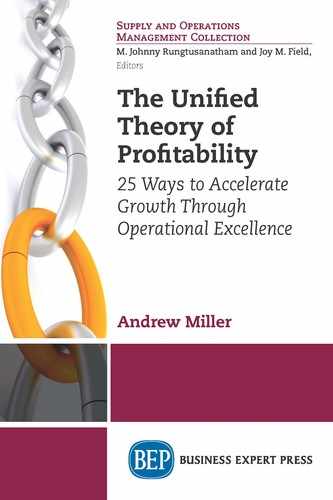Setting the Right Expectations and Measuring Performance
Now that we have a clear vision of the future for our organization (see Chapter 9), and our employees have a pretty good sense of what they can do to help the organization progress toward that vision, we need to set up a more formal way for this to happen. We need to set expectations with each employee and then measure performance based on the expectations we have set.
Let us use two examples from my client work to help illustrate how this can be done.
Example #1: Midsized Medical Device Company
I was recently working with a mid-sized medical device company to help execute their strategic plan. We established a clear vision of the future (growing into two new specific markets). We then needed to translate that vision into action.
I met with the leadership team to develop an implementation plan on how we were going to achieve that vision. The implementation plan consisted of the tactics they needed to employ in order to grow into these two new markets, the person accountable for performing each of those tactics, by when they would be completed, and what would be a successful outcome.
One of the tactics was that we needed to assess the skills and abilities of the sales representatives to sell the products required to help them grow into these new markets. In order to do that, I helped them identify the key behaviors that a top sales rep would exhibit. We came up with seven key behaviors. We then asked each sales rep to assess themselves against these seven behaviors (we asked them to give themselves a score from 1 to 5 on each). We asked their managers to assess them as well.
Once these assessments were complete, we had a strong sense of what training and skills each individual needed, and also areas where the majority of the team was weak and needed more support.
These behaviors helped set expectations. My client was telling the sales representatives about the behaviors they expect the sales representatives to exhibit and that the client would provide them the support to improve their performance in these areas. The behaviors were then built into the performance review for each sales representative and became the foundation for successful growth into these new markets.
Example #2: Large Global Health Care Distribution Company
On this client project, the focus was to work with my client’s team to have more proactive discussions with business partners and be considered a strategic adviser to them. The outcome of this would be larger partnership deals, higher fees, and expansion into new services being offered.
Similar to the previous client example, I worked with the client to identify the key behaviors we expected to see. We asked, “What would the characteristics and behaviors of a top-performing person be?” In this case, we came up with five. Some were related to better preparation for meetings with business partners, whereas others were focused on the language to be used and the questions to be asked during meetings with business partners.
I then developed tools for the team to use to help them exhibit the expected behaviors. We role-played specific situations that came up often. We gave them the opportunity to share successes and failure, and more importantly why each situation was a success or failure. We encouraged them to attend each other’s meetings when possible and give each other constructive feedback. We even developed a clear value proposition for them to use in meetings.
The results were clear in a short period of time. The fees became higher. The conversations with business partners became less contentious. The value proposition made its way through the organization so that the CEO was even using it on investor calls. Everyone knew his or her role in helping the organization progress toward its future state.
Again, the keys to success were having a clear future state vision, involving the team in the identification of the key behaviors, clearly communicating what behaviors were expected of them, and measuring their performance (at least partially) based on how they exhibited those behaviors. Therefore, setting expectations and measuring performance is not rocket science. The following is what you need to do:
1. Develop a clear vision for the future.
2. For each department, division, or group of employees, identify the expected behaviors that will help you progress toward that future vision.
3. Integrate those behaviors into performance reviews.
4. Provide tools and support to help employees exhibit the proper behaviors.
It sounds simple, does it not? It is actually simple; it is just not easy. Consider the aforementioned examples and how to replicate that in your own organization.
